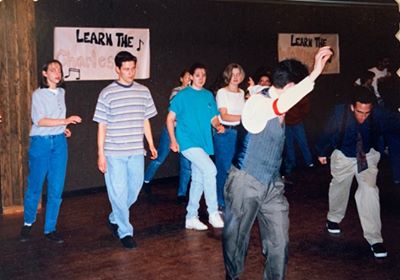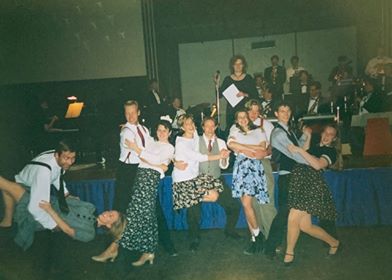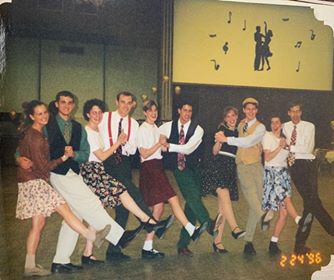For a small community in Utah, 1920s–40s swing dancing is still alive and kicking.
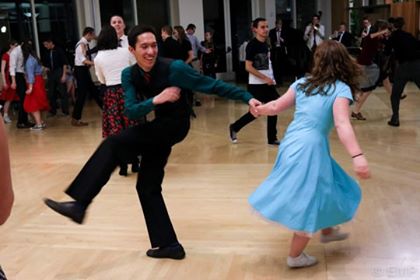
“If you think of any black-and-white movie that you see partner dancing in with swirly skirts — that’s probably it,” said recent BYU graduate Alyssa Nelson, who has been swing dancing for more than five years.
Vintage swing dancing, an umbrella term including styles such as the Charleston and Lindy Hop, is “silly,” said Nelson, and allows for creativity.
“You get to kind of goof off while you’re dancing with someone and build off each other’s input,” she said.
Susa Lindsey, a dancer from West Jordan, described the dancing as pure joy. “There are rules in dancing and in Lindy Hop, but you’re always doing new things!”
Provo resident and swing dancer Catherine Patterson Crenshaw said swing is bouncy and energetic.
The American style of dancing, dating back to Harlem in the late 1920s, saw a revival in popularity in the 1990s and is still danced all over the world today.

About 25 years ago, the BYU Swing Kids club was created and quickly grew within a semester to become the school’s most popular club at the time, with about 300 members. Club founder Kacy Humberstone Moller said swing dancing caught fire in the area following the release of the 1993 film “Swing Kids,” starring Robert Sean Leonard and Christian Bale.
It was appealing socially, Moller said. The club provided a safe space for students to meet people and dance to clean music. The 40–50 “die-hard” members would meet often, about five days per week, to dance. They taught lessons, formed a performing team and brought in live bands and showcased guest teachers for club activities.
Today, the club continues to operate, albeit with a much smaller active membership. Recently renamed the BYU Vintage Swing Dance Club, it continues to have weekly Saturday lessons and dances in the Richards Building, just as members have been doing since 1995.
Utah, however, faces multiple obstacles when it comes to preserving a fervor for this unique passion, and the local swing community, or “swing scene,” has shrunk in the last 10 years.
According to Nelson, who had her first swing dance lesson at the Swing Kids club and later served as club president, the swing dance hot spots in Utah are St. George, Salt Lake City, Logan and Provo, with Provo being the weakest.
In one word, she said she would call the Utah swing community “resilient,” as the dancers face many barriers to keeping the art alive.
BYU sophomore Paul Crenshaw, Catherine’s husband and a prominent member of the swing dance community, attributes several factors to swing’s struggle in Utah.
Utah is isolated — a “dance desert,” Crenshaw said. “You go five hours north, you’ve got Boise, and Boise is a relatively small dance community. You go seven hours east, and you’ve got Denver, and Denver has a legitimate, big dance scene. You go nine hours west, and you’ve got Sacramento, and Sacramento has a big, thriving dance scene. But there’s nothing in between.”
Originally a resident of Virginia, Crenshaw was used to being surrounded by thriving swing dance scenes and big events in Washington D.C., Virginia Beach, Baltimore, Charlottesville, Raleigh and Asheville, the location of one of the biggest swing dance events of the year, all within a short distance.
He said it is harder for dancers to get to Utah and that the dance scene is suffering.
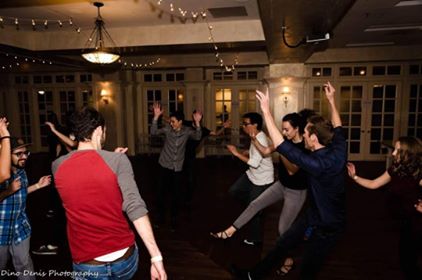
Crenshaw also cited a historical stigma and suspicion surrounding jazz music, a lack of swing bands, tightened BYUSA club regulations, dating culture, a decline in awareness and interest about swing and a period of scandal in the Utah swing scene as additional deterrents.
“Unfortunately, there have been people who are very touchy-feely in a pervy way,” he said.
A little more than five years ago, according to Crenshaw, the swing scene had its own “Me Too” movement, with many dancers stepping forward about sexual abuse they had experienced from members of the dance community, a revelation that he said “rocked everything.”
Now, dance venues guard against a repeat of such abuse by adopting codes of conduct and banning known abusers. Still, the incidents upset the community and resulted in a decrease in the number of dancers.
According to Crenshaw, there were many accomplished dancers who stopped attending events because they were afraid of meeting their abusers.
He said there had not been a structure in place to protect them. “And because of that, swing dancing suffered,” Crenshaw said.
Despite these hardships, the swing community lives on. Lindsey compared it to a family. “I know wherever I go there will be people I will call friends and who will help me, dance with me, laugh and have fun!” she said.
The friendship aspect is what drew both Catherine Crenshaw and Nelson to the dance in the first place. Nelson said most of her friends are from swing dancing, and they led her not only to dancing at BYU but also swinging in Salt Lake City at bigger events.
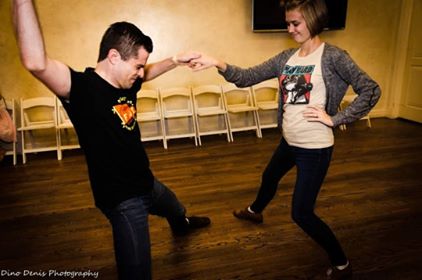
“People don’t realize how much they need a supportive community until they’ve got one.” Catherine Crenshaw said.
She recounted an experience she had while attending a swing dancing event last year. She was surrounded by “this whole network of people in varying degrees of closeness to me … and I knew if anything happened to me, they would rally around me.”
“I just had this moment where I looked around,” she said. “I was like, most people live without this. Most people live without this village feeling, and for me, that was a perspective change moment where I was like, wow, I’m really, really lucky to have this.”

